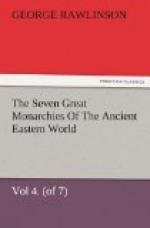The worship of the Babylonians appears to have been conducted with much pomp and magnificence. A description has been already given of their temples. Attached to these imposing structures was, in every case, a body of priests; to whom the conduct of the ceremonies and the custody of the treasures were intrusted. The priests were married, and lived with their wives and children, either in the sacred structure itself, or in its immediate neighborhood. They were supported either by lands belonging to the temple, or by the offerings of the faithful. These consisted in general of animals, chiefly oxen and goats; but other valuables were no doubt received when tendered. The priest always intervened between the worshipper and the deities, presenting him to them and interceding with uplifted hands on his behalf.
In the temple of Bel at Babylon, and probably in most of the other temples both there and elsewhere throughout the country, a great festival was celebrated once in the course of each year. We know little of the ceremonies with which these festivals were accompanied; but we may presume from the analogy of other nations that there were magnificent processions on these occasions, accompanied probably with music and dancing. The images of the gods were perhaps exhibited either on frames or on sacred vehicles. Numerous victims were sacrificed; and at Babylon it was customary to burn on the great altar in the precinct of Bel a thousand talents’ weight of frankincense. The priests no doubt wore their most splendid dresses; the multitude was in holiday costume; the city was given up to merry-making. Everywhere banquets were held. In the palace the king entertained his lords; in private houses there was dancing and revelling. Wine was freely drunk; passion Was excited; and the day, it must be feared, too often terminated in wild orgies, wherein the sanctions of religion were claimed for the free indulgence of the worst sensual appetites. In the temples of one deity excesses of this description, instead of being confined to rare occasions, seem to have been of every-day occurrence. Each woman was required once in her life to visit a shrine of Beltis, and there remain till some stranger cast money in her lap and took her away with him. Herodotus, who seems to have visited the disgraceful scene, describes it as follows. “Many women of the wealthier sort, who are too proud to mix with the others, drive in covered carriages to the precinct, followed by a goodly train of attendants, and there take their station. But the larger number seat themselves within the holy inclosure with wreaths of string about their heads—and here there is always a great crowd, some coming and others going. Lines of cord mark out paths in all directions among the woman; and the strangers pass along them to make their choice. A women who has once taken her seat is not allowed to return home till one of the strangers throws a silver coin into her lap, and takes her with him beyond the holy




